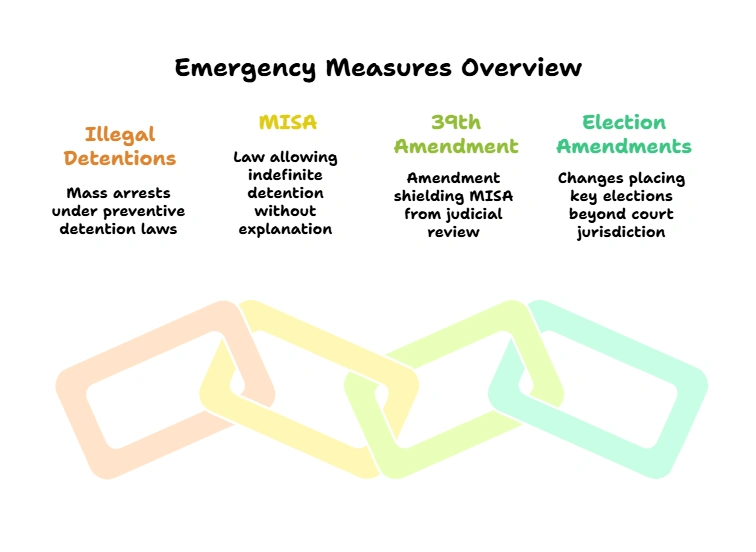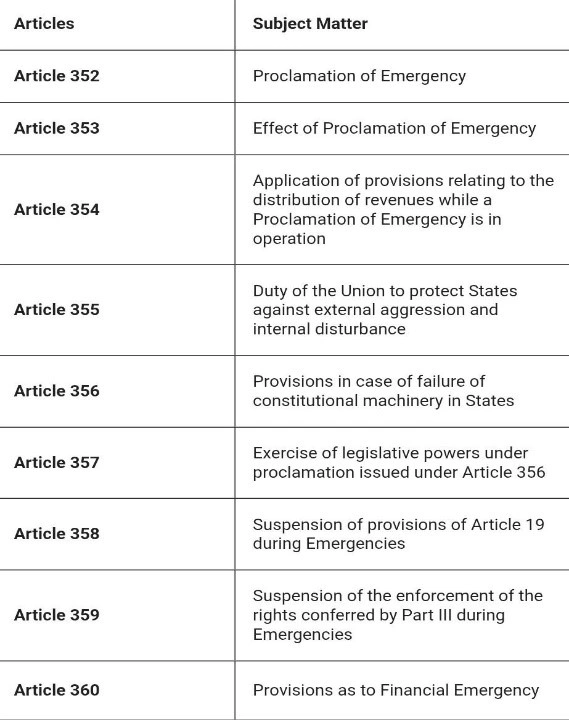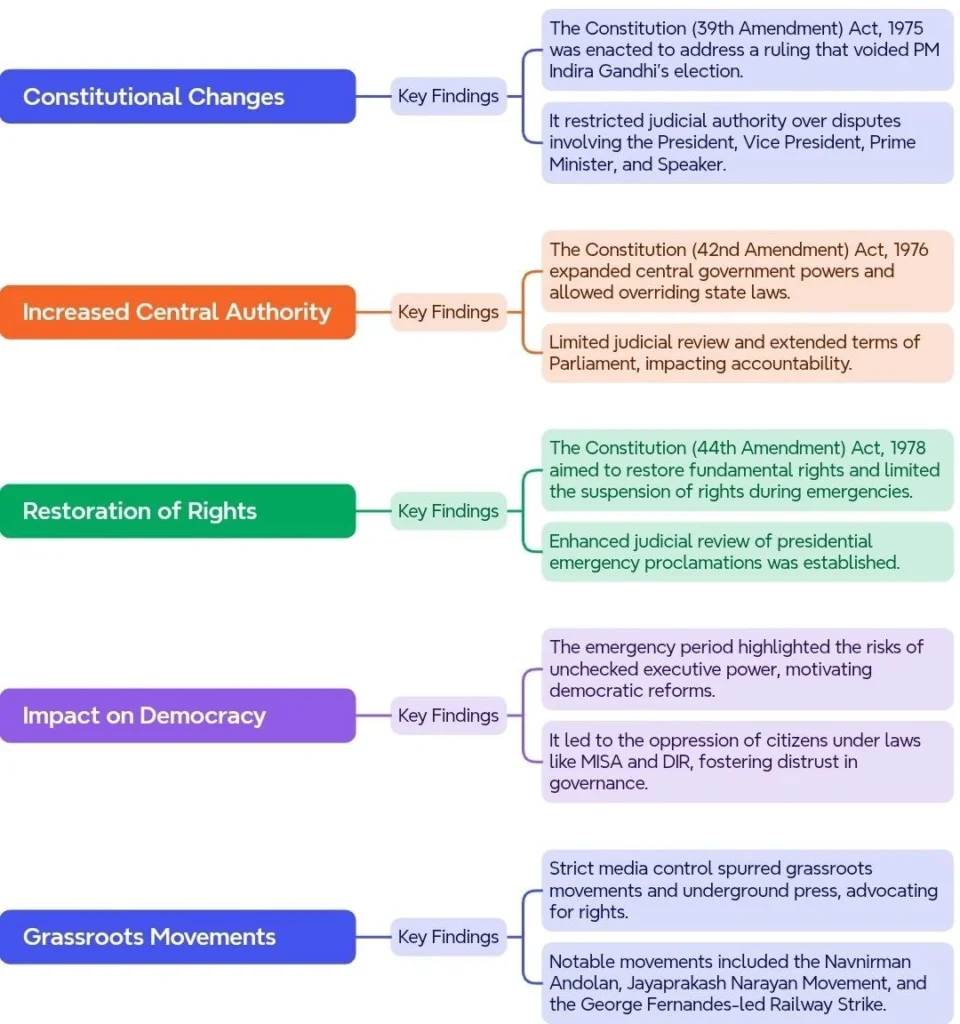Paper: GS – II, Subject: Polity, Topic: Executive, Issue: Emergency imposed in India 50 years ago.
Context:
The Emergency in India was imposed 50 years ago on June 25, 1975. Lasting 21 months, it is considered one of the darkest periods in Indian democratic history, marked by the suspension of civil liberties, press censorship, mass arrests, cancellation of elections, and governance by executive decree.

Key Takeaways:
What is an Emergency?
- About: It refers to legal measures and clauses within a country’s constitution or laws that enable the government to respond swiftly and effectively to extraordinary situations, such as war, rebellion, or other crises that threaten the nation’s stability, security, or sovereignty and democracy of India.
- Provisions in Constitution: These provisions are outlined in Article 352 to Article 360 under Part XVIII of the Constitution.
- The emergency provisions in the Indian Constitution draw inspiration from Germany’s Weimar Constitution.

| National Emergency (Article 352): Under Article 352, the President is empowered to declare a state of emergency if he is satisfied that the security of the country or any part thereof is threatened by war, external aggression (External Emergency), or armed rebellion (Internal Emergency). The term ‘armed rebellion’ was inserted by the 44th amendment replacing internal disturbance. The declaration grants the executive vast powers to suspend fundamental rights (except Articles 20 and 21), allowing the government to take necessary measures to address the crisis effectively. Duration and Parliamentary Approval: The proclamation of emergency must be approved by both the houses of Parliament within one month from the date of its issue. However, if the proclamation of emergency is issued at a time when the Lok Sabha has been dissolved without approving the proclamation, then the proclamation survives until 30 days from the first sitting of Lok Sabha after its reconstitution, provided the Rajya Sabha has in the meantime approved it. If approved by both the houses, the Emergency continues for 6 months and can be extended to an indefinite period with an approval of the Parliament for every six months. Every resolution approving the proclamation of emergency or its continuance must be passed by either House of Parliament by a special majority. Revocation of Proclamation: A proclamation of Emergency may be revoked by the President at any time by a subsequent proclamation. Such proclamation does not require parliamentary approval. The emergency must be revoked if the Lok Sabha passes a resolution by a simple majority disapproving its continuation. |
Impact of Imposing National Emergency in 1975:

Evolving Role of Judicial Activism:
- ADM Jabalpur v. Shivkant Shukla, 1976 upheld the suspension of fundamental rights during an emergency.
- It argued that the right to life could be restricted by the government for national security. This decision sparked outrage and accusations of judicial overreach, weakening the protection of fundamental rights.
- Habeas Corpus Petitions: These petitions, filed by individuals detained during the Emergency, challenged the government’s actions. This marked a shift towards a more robust judicial review.
- State of Uttar Pradesh v. Raj Narain, 1975, Supreme Court ruled Prime Minister Indira Gandhi guilty of electoral malpractices which highlighted the judiciary’s independence even during a politically sensitive time.
Changes in Political Parties’ Attitude:
- The Emergency united previously disparate opposition parties.
- This underscored the importance of a strong opposition in a democracy.
- Political parties became wary of resorting to similar measures in the future, valuing democratic processes.
India’s Constitution has emergency provisions that include checks and balances, preventing their misuse. These measures safeguard democracy, uphold the rule of law, and protect individual rights during crises. They ensure the Union government remains accountable within constitutional and democratic frameworks.
https://indianexpress.com/article/explained/explained-emergency-its-lessons-10086542
La Excellence IAS Academy, the best IAS coaching in Hyderabad, known for delivering quality content and conceptual clarity for UPSC 2025 preparation.
FOLLOW US ON:
◉ YouTube : https://www.youtube.com/@CivilsPrepTeam
◉ Facebook: https://www.facebook.com/LaExcellenceIAS
◉ Instagram: https://www.instagram.com/laexcellenceiasacademy/
GET IN TOUCH:
Contact us at info@laex.in, https://laex.in/contact-us/
or Call us @ +91 9052 29 2929, +91 9052 99 2929, +91 9154 24 2140
OUR BRANCHES:
Head Office: H No: 1-10-225A, Beside AEVA Fertility Center, Ashok Nagar Extension, VV Giri Nagar, Ashok Nagar, Hyderabad, 500020
Madhapur: Flat no: 301, survey no 58-60, Guttala begumpet Madhapur metro pillar: 1524, Rangareddy Hyderabad, Telangana 500081
Bangalore: Plot No: 99, 2nd floor, 80 Feet Road, Beside Poorvika Mobiles, Chandra Layout, Attiguppe, Near Vijaya Nagara, Bengaluru, 560040

